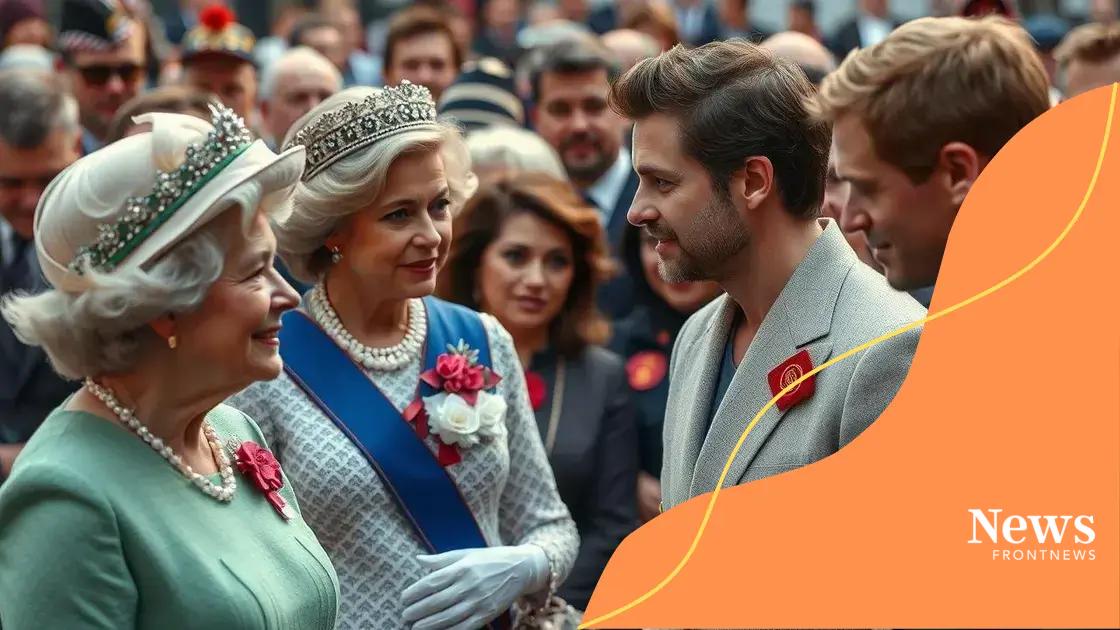Monarchy Update: Is It Time for a Change?

Constitutional monarchies adapt to modern societal changes by engaging with the public, addressing relevant social issues, and ensuring transparency, while navigating challenges such as economic instability and public scrutiny.
The Monarchy Update presents an intriguing look at how royal families are adapting to the modern world. Have you ever considered the challenges they face in our fast-changing society? Let’s dive into this fascinating subject.
Current state of monarchies worldwide
Today, the current state of monarchies worldwide showcases a fascinating blend of tradition and modernity. As we observe various royal families, it’s interesting to see how they function in contemporary society, adapting to changing values and expectations.
Types of Monarchies
There are several forms of monarchy, each presenting unique characteristics. Some monarchies have significant power, while others serve in a more ceremonial role. To understand their differences, consider the following:
- Absolute Monarchies: The monarch has almost complete control over the state.
- Constitutional Monarchies: The monarch’s powers are defined and limited by a constitution.
- Elective Monarchies: The monarch is selected, rather than inheriting the position.
This variety profoundly impacts how monarchies relate to their citizens. For instance, in constitutional monarchies like the United Kingdom, the royal family’s role is mainly symbolic, promoting national unity and culture. In contrast, absolute monarchies, such as Saudi Arabia, hold significant political power, influencing governance directly.
Public Sentiment Toward Monarchies
Public opinions about monarchies vary greatly across countries. In some nations, such as Sweden and Denmark, the royal family enjoys strong support, often viewed as a symbol of national identity. However, in other places, there are increasing calls for reform or even abolition, especially in regions where economic disparities highlight the contrast between the monarchy and the general populace.
Social media also plays a significant role in shaping public perception. It provides a platform for discussions about royal behavior, decisions, and lifestyles, making the monarchy more accessible and sometimes scrutinized. This new level of visibility allows citizens to relate more closely to royal figures while demanding accountability.
Overall, the dynamics of monarchy today reflect a world that is rapidly changing. Whether embracing modern values or clinging to tradition, royal families must navigate these challenges carefully. It will be intriguing to watch how they evolve in response to the needs and desires of their people.
Historical evolution of modern monarchies
The historical evolution of modern monarchies reveals a fascinating journey from absolute power to more symbolic roles. Over time, many monarchies have adapted to the changing needs of society. Let’s explore key developments that shaped their current forms.
Roots of Monarchy
Monarchy has ancient origins, with rulers often seen as divinely appointed. Early monarchies were primarily focused on consolidating power and land. This system created hierarchies that shaped many societies.
As nations grew, so did the complexities of governance. Changes began to emerge during the Middle Ages, particularly with the rise of feudalism. In this system, local lords held power, while kings and queens ruled with varying degrees of authority.
Transition to Constitutional Monarchies
The transition from absolute to constitutional monarchies marks a critical turning point. One significant event was the Magna Carta in 1215, which limited the power of the English king and established rights for nobles. This set the stage for the modern concept of governance, where monarchs must share power.
Over time, revolutions in countries like France and the United States further influenced this evolution. The French Revolution, for example, challenged the divine right of kings and led to the establishment of a republic. Despite initial backlash, these changes prompted many crowns to reconsider their roles.
Modern Adaptations
Today, many monarchies operate within a constitutional framework. In countries like the United Kingdom and Norway, monarchs have limited powers, primarily serving as ceremonial figures. This shift reflects a greater emphasis on democracy and the rule of law.
- Symbolic Roles: Modern monarchs often participate in cultural and national events, reinforcing national identity.
- Public Engagement: Increased visibility through social media allows royal families to connect with citizens.
- Political Influence: While their power may be limited, monarchs often influence public opinion and national dialogue.
This evolution indicates how modern monarchies adapt to societal expectations while maintaining historical traditions. As we observe these changes, we see that their roles continue to evolve in response to the needs of their citizens.
Public perception of monarchy today

Today, the public perception of monarchy varies greatly across different nations. Some people view monarchies as obsolete institutions that represent outdated values, while others see them as important cultural symbols that unite communities.
Recent surveys indicate that in countries like the United Kingdom, many citizens still support the monarchy. A majority appreciates the royal family’s role in preserving tradition and promoting national pride. In contrast, in nations facing economic hardships, the royal family may be scrutinized for their lavish lifestyles.
Factors Influencing Public Opinion
Several factors shape how people perceive monarchies today. These include:
- Media Coverage: The portrayal of royal events in the media significantly influences public opinion. Events that showcase royal charity work, for instance, improve public perception.
- Social Media: Platforms like Twitter and Instagram allow for direct communication between the monarchy and the public. This accessibility can foster a sense of connection.
- Scandals: Controversies involving members of the royal family can change public sentiment rapidly. Scandals can lead to calls for reform or even abolition in some cases.
Public engagement has increased due to royal initiatives aimed at connecting with younger generations. Modern monarchs often embrace social issues, demonstrating their relevance in today’s world. For example, many royal families advocate for environmental causes and mental health awareness, drawing attention to important issues.
Generational Perspectives
Young people today often have different views on monarchy compared to older generations. Surveys show that while younger individuals might be more critical of the monarchy, they also recognize its unique place in history. This contrasting view creates a complex dynamic as traditions are re-evaluated in light of modern values.
The future of monarchy will depend on how well royal families adapt to these changing perceptions. Engaging with the public transparently and addressing concerns can help maintain their relevance and support. By understanding these factors, royal families can navigate the challenges of the 21st century effectively.
The impact of social media on royal images
The impact of social media on royal images has been profound, reshaping how royal families communicate and engage with the public. In today’s digital age, monarchies have embraced platforms like Instagram, Twitter, and Facebook to share their stories and connect with citizens.
Previously, traditional media controlled the narrative around royal families. Now, social media allows them to present their image directly, shaping perceptions in real-time. This shift provides opportunities for engagement but also poses challenges, as public scrutiny increases.
Enhancing Visibility
Royal families have found social media to be a valuable tool for enhancing visibility. They share personal moments, charity work, and public appearances, making them more relatable. This strategy helps humanize royal figures, allowing people to see them as more than just symbols of tradition.
- Real-time Updates: Social media allows for instant updates on royal events, making the monarchy more accessible.
- Interactive Content: Royal accounts frequently use polls and Q&A sessions to engage with followers, fostering community.
- Humanizing Royals: Personal posts, like family moments or hobbies, help create a relatable image.
However, the constant presence on social media comes with risks. Royal families must be cautious about their public image since every post is subject to immediate criticism and interpretation. One controversial post can lead to widespread backlash, highlighting the challenges of navigating public relations in a digital world.
Addressing Public Issues
In recent years, members of royal families have participated in discussions on relevant social issues via social media. They often promote causes such as mental health awareness and environmental sustainability. This involvement signals to the public that they are attuned to contemporary concerns, indicating a desire to be part of the solution.
Engaging with followers on these platforms can enhance their image and relevance in society. By addressing public issues, they show growth and adaptability, essential for gaining the support of younger generations.
The potential for social media to influence royal images continues to grow. As these platforms evolve, royal families must find ways to balance modern engagement with tradition, ensuring they remain meaningful symbols while adapting to the demands of today’s world.
Future prospects for constitutional monarchies
The future prospects for constitutional monarchies remain an intriguing topic as these institutions navigate a rapidly changing world. As democracies evolve and public expectations shift, the role of monarchies must adapt to maintain relevance.
Constitutional monarchies have already shown resilience, often thriving in stable political environments. They serve as unifying symbols of national identity, blending tradition with contemporary governance. In countries like Sweden and Japan, the royal families participate in cultural events, creating a sense of continuity and stability.
Adapting to Change
To remain relevant, constitutional monarchies must adapt in several key areas:
- Public Engagement: Increasing transparency and public involvement can help strengthen the connection between the monarchy and citizens.
- Modern Social Issues: Embracing contemporary social issues, such as climate change and equality, can enhance their public image.
- Charitable Involvement: Continued focus on charitable activities can promote the monarchy as a force for good in society.
The younger generations are vital to the future of constitutional monarchies. Their views are often more progressive, and royal families must resonate with these ideals while remaining true to their traditions. Engaging youth on social media platforms is one way to establish that connection.
Challenges Ahead
However, constitutional monarchies face challenges, especially in countries with economic or political strife. Calls for reform or even abolition persist in some regions. Maintaining public support requires ongoing efforts to demonstrate relevance and accountability in governance.
Moreover, the spread of misinformation and shifts in public opinion can pose risks. Royal families must navigate this landscape carefully, promoting a positive image while addressing concerns effectively. As these challenges arise, the ability to adapt will be crucial for the survival of constitutional monarchies.
In summary, while the future of constitutional monarchies is not without obstacles, there is also considerable potential for growth and reinvention. By focusing on public engagement, addressing modern issues, and connecting with younger generations, these institutions can thrive in a changing world.
FAQ – Frequently Asked Questions about Constitutional Monarchies
What is a constitutional monarchy?
A constitutional monarchy is a system of government where a monarch acts as the head of state within the boundaries set by a constitution.
How do constitutional monarchies remain relevant today?
They remain relevant by engaging with the public, addressing social issues, and adapting to modern values while preserving traditions.
What challenges do constitutional monarchies face?
Constitutional monarchies face challenges such as public scrutiny, calls for reform, and the need to balance tradition with contemporary expectations.
How can royal families connect with younger generations?
Royal families can connect with younger generations through social media, community engagement, and by addressing issues important to them.





